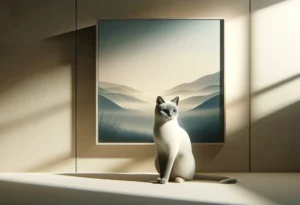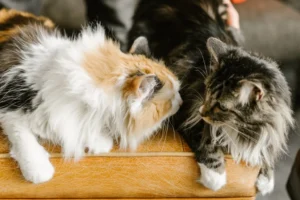Cats have a way of captivating us with their mysterious and enigmatic gaze. But have you ever noticed that they often avoid looking you directly in the eye? Have you ever wondered why cats can’t seem to hold eye contact like dogs can?
They have a natural instinct inherited from their wild ancestors that causes them to avert their eyes to avoid conflict or appear non-threatening. This behavior can be traced back to their days in the wild when direct eye contact was perceived as a challenge or threat. So, the next time your feline friend looks away when you’re trying to connect with them, remember that it’s just their way of communicating.
Evolutionary Behavior
Cats have a fascinating evolutionary history that sheds light on why they may not always look you in the eye. In the wild, direct eye contact can be perceived as a threat. Predators often stare down their prey before attacking, so avoiding eye contact can be a survival instinct for cats.
Interestingly, cats also use their eyes to communicate with each other. A slow blink from a cat is a sign of trust and affection, while dilated pupils can indicate fear or aggression. So when your cat avoids your gaze, it could be their way of feeling safe or showing respect.
Communication Signals
When your cat avoids eye contact, they might be trying to communicate something important . Just like us, cats express emotions through their eyes. A direct stare can be interpreted as a challenge in the feline world, so your cat may be trying to avoid confrontation by looking away.
Additionally, cats are masters of body language. If your cat looks away when you make eye contact, they might be feeling stressed or anxious. Take note of their overall body posture and behavior to better understand how they’re feeling.
Unique Insight : Cats may also look away if they are feeling overwhelmed by too much stimulation. Giving them space and allowing them to approach you on their terms can help strengthen your bond and build trust over time.
Establishing Dominance
When it comes to why cats can’t look you in the eye, it often ties back to establishing dominance. In the feline world, direct eye contact is seen as a challenge or a threat. Cats are naturally territorial animals, and eye contact can be interpreted as a sign of dominance. To avoid confrontation or aggression, cats may avoid looking directly at you or may gaze off to the side. This behavior is deeply ingrained in their instincts and is a way for them to maintain peace within their social hierarchy.
Key Insight: Cats may also blink slowly when making eye contact with you, which is a sign of trust and non-aggression in the feline world. This slow blink is known as a “cat kiss” and can help to build a positive bond between you and your feline friend.
Trust Building
Building trust with your cat is essential for a strong and healthy relationship. While cats may avoid direct eye contact to establish dominance, they also use other forms of communication to build trust. Through behaviors like rubbing against you, purring, and kneading, cats show affection and trust in their own unique ways. Eye contact is just one aspect of their communication style.
- Physical Touch: Cats often show trust through physical touch, such as rubbing against your legs or sitting on your lap. This physical closeness helps strengthen the bond between you and your cat.
- Playtime: Engaging in interactive play sessions with your cat can also help build trust. By playing together, you are establishing a positive and fun connection with your feline companion.
- Respect Boundaries: Recognizing and respecting your cat’s boundaries is crucial for building trust. Give them space when needed and allow them to approach you on their terms.
By understanding your cat’s unique communication style and behaviors, you can strengthen your bond and build trust over time. Trust is the foundation of a strong and lasting relationship with your feline companion.
Cat Body Language
When your furry feline friend avoids making eye contact with you, it doesn’t mean they’re ignoring you or being rude. Cats have their own unique way of communicating through their body language. While eye contact might be less common, they express themselves in various other ways:
- Tail position: A cat’s tail can give you insights into their mood. A high, straight tail often signifies confidence, while a tucked tail indicates fear or submission.
- Purring: This soothing sound isn’t always a sign of contentment. Cats also purr when they’re anxious or in pain, so pay attention to their overall body language.
- Ears: Your cat’s ears can tell you a lot. Forward-facing ears usually indicate a calm or alert cat, while flattened ears signal aggression or fear.
Understanding these subtle cues can help you better interpret your cat’s emotions, even when direct eye contact isn’t their preferred method of communication.
Training and Socialization
Training and socialization play a crucial role in helping your cat feel comfortable making eye contact with you. By starting early and creating positive experiences, you can encourage your cat to build confidence in this form of interaction. Here are some tips to help your cat become more at ease with eye contact:
- Positive reinforcement: Reward your cat with treats or affection when they engage in eye contact, gradually increasing the duration over time.
- Respect their boundaries: Some cats may never be fully comfortable with prolonged eye contact, so be mindful of their preferences and body language cues.
- Slow introductions: If your cat is hesitant, start with brief periods of eye contact and gradually work your way up as they become more relaxed.
By incorporating these strategies into your interactions with your cat, you can help them feel more secure and build a stronger bond based on trust and understanding.
Medical Considerations
When it comes to why your cat may avoid eye contact, it’s essential to consider any potential medical issues that could be at play. Cats, just like humans, can experience eye problems that may make them hesitant to look you in the eye. Common medical conditions that could affect a cat’s vision include cataracts, glaucoma, and conjunctivitis. If you notice your cat consistently avoiding eye contact, blinking excessively, or showing signs of discomfort around their eyes, it’s crucial to consult your veterinarian. Regular check-ups can help catch any eye issues early on and ensure your feline friend’s vision stays healthy. Remember, your cat’s well-being is always a top priority!
Fun Fact: Cat Vision
Did you know that cats have unique vision abilities that differ from humans? These feline friends have more light-sensitive cells in their retinas, allowing them to see in low light conditions better than us. However, this also means that their visual acuity (sharpness of vision) is lower compared to humans. Cats have a wider field of view, allowing them to detect movement and see things on the periphery more effectively. This unique vision perspective may explain why cats sometimes avoid direct eye contact. For them, it’s more about scanning their surroundings and staying alert to any potential threats. Understanding how cats see the world differently can help us appreciate their behavior and establish a stronger bond with our furry companions. So next time your cat looks away, remember they’re just seeing things from a different perspective!
Alex, a passionate animal lover, has experience in training and understanding animal behavior. As a proud pet parent to two dogs and three cats, he founded AnimalReport.net to share insights from animal experts and expand his knowledge of the animal kingdom.









